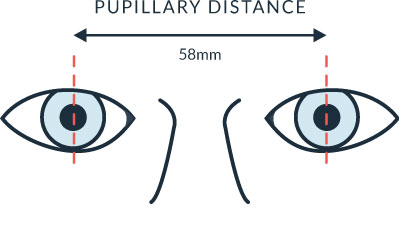
We offer lenses for virtually all frame types. It is not recommended to measure a PD using a picture as this method does not account for convergence and gives a large error that can cause eye strain.īe sure to browse the entire selection of eyeglass lenses from ReplaceALens today. The other accepted method is marking the pupil center with a permanent marker by isolating one eye at a time, but this method is very difficult to master. The most accepted method is using a Pupilometer, which is a device held up by an optician in front of a patient, giving monocular Right and Left eye PD measurements. An accurate pupillary distance (PD) measurement is required in order to make prescription glasses, and you cannot purchase lenses from. There are many ways that the industry measures a PD. If there is a PD written with two PD’s, like 55/52, or 29/28, this can be either a Far PD/Near PD, or a Left PD/Right PD, which can be determined by the size of the number as Far/Near is ‘binocular’ and Left/Right is ‘monocular.’ How is a Pupillary Distance (PD) measured? It is best practice to always write each eye individually, called ‘monocular’ measurements. This is called a ‘binocular’ PD measurement. When the Right Eye PD equals the Left Eye PD, then sometimes the PD is written as just one number. There are technically four different PD measurements as follows:Įyeglass lens laboratories only need the Far PD measurement to produce lenses. How is the Pupillary Distance (PD) written? What is the nomenclature? Before using our PD tool, review the steps below. This means that there is a high chance that measuring your PD yourself will cause deteriorated vision and eyestrain, especially as the Rx gets stronger. PD is the distance between your pupils, and its used to help center a prescription correctly in your frames. The methods available online to do so, from the credit card picture, to the rulers, have an error higher than the ANSI lens production tolerances. The required accuracy of this measurement is one millimeter per eye. While it is possible to measure your own PD, it is not recommended. Can I measure my Pupillary Distance (PD) myself? The higher the prescription, the more a PD error will be noticed.

If the PD is incorrect, then the actual location of objects you are looking at will move, an effect called ‘prismatic imbalance.’ This usually feels like a pulling sensation, making your lenses uncomfortable to wear and causing eyestrain.


What is the effect of an incorrect Pupillary Distance (PD) measurement? The PD measurement acts as a guide to make sure the lenses have been centred according to the position of your pupils. This allows the optical center of the lens to be aligned in front of the optical center of your eye during the manufacturing of eyeglass lenses. If there isnt one listed on your Rx, this article will. Your PD measurement dictates the horizontal placement of the optical center of the eyeglass lens. Ever wonder what the term PD means on your glasses prescription It stands for pupillary distance. Why is the Pupillary Distance (PD) important? You have a Right Eye (OD) PD and a Left Eye (OS) PD, which can be different and are measured from the center of the nose to each eye independently. The PD, which stands for pupillary distance, is the distance between your pupils in millimeters.


 0 kommentar(er)
0 kommentar(er)
